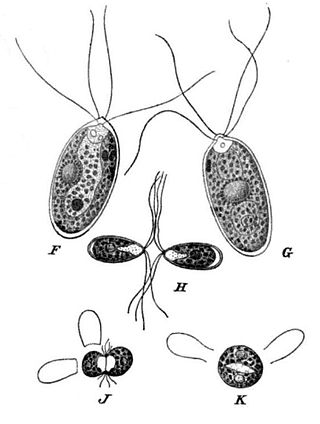Top Qs
Timeline
Chat
Perspective
Carteria
Genus of algae From Wikipedia, the free encyclopedia
Remove ads
Carteria is a genus of green algae in the family Chlamydomonadaceae.[1] Carteria are similar in morphology to the common genus Chlamydomonas and differ by having four, rather than two, flagella at the vegetative stage.[2]
The genus name of Carteria is in honour of Henry John Carter, (1813–1895), who was a surgeon working in Bombay, India, who carried out work in geology, paleontology, and zoology.[3]
The genus was circumscribed by Karl Moritz Diesing in Sitzungsber. Kaiserl. Akad. Wiss., Wien, Math.-Nat. Cl., Abt. Vol.1 Issue 52 on page 356 in 1866.
Remove ads
Description
Carteria is a single-celled organism. The cell is surrounded by a conspicuous wall which is often differentiated into a papilla at the anterior of the cell. There are four flagella, inserted at the location of the papilla, with a cruciate arrangement. Cells contain a single chloroplast. Pyrenoids are present, with one or several. There are often two contractile vacuoles per cell.[4]
Asexual reproduction occurs via zoospore formation within the parent cell wall.[2] The mode of sexual reproduction varies within Carteria: some species are isogamous, while Carteria obtusa is anisogamous.[5]
Remove ads
Taxonomy
Over seventy species of Carteria have been described from freshwater and terrestrial habitats.[4] The chloroplast shape is species-specific and provides the basis for classification.[6]
Among the 4-flagellate algae, various genera have been split off from Carteria based on morphological evidence. Among them are Provasoliella, which lacks pyrenoids,[7] and Pseudocarteria, which has multiple (more than two) contractile vacuoles dispersed throughout the cytoplasm.[8]
It is likely that additional research will lead to further revision of this genus.[6] Based on the ultrastructure of the flagellar basal bodies, Lembi et al. divided Carteria into two groups. Group I contains spherical cells with flagellar bodies oriented in a cross. Group II contains ellipsoidal cells with flagellar bodies oriented in a four-armed spiral.[9] Molecular data also agree with this grouping; the two groups together do not form a monophyletic group.[5]
Remove ads
References
Wikiwand - on
Seamless Wikipedia browsing. On steroids.
Remove ads

